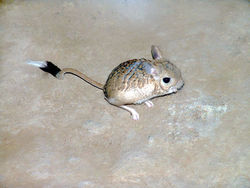
- Euchoreutes naso Long-eared jerboa
- Dipus sagitta Northern Three Toed Jerboa
- Salpingotulus michaelis Baluchistan pygmy jerboa
| Jerboa |
|---|
 |
| Scientific Classification |
| Genera and Species |
|
| Greater Egyptian Jerboa |
The Jerboa is a desert rodent that is native to Asia. They are perhaps known for their amazing jumping capability. There are over 30 different species of Jerboas, many of which are bred in captivity and used as common pets. [2]
The Jerboa has similar traits to that of a [mouse], [cat], [squirrel], [jackrabbit], kangaroo], and [prairie dog]. The Jerboa typically grows up to two inches and usually weighs a few ounces. Its head is similar to a mouse, and is designed for burrowing and nocturnal activity. Their large ears are protected by bristly hairs, and its teeth are grooved incisors and powerful molars. It also sensory whiskers for feeling during nocturnal activity in their burrows.[3] Its body is rat shaped and is coated with long silky fur usually a sandy color that helps its camouflage itself withs its surroundings.[4] The hind legs are typically four times longer than the front legs and were designed for the purpose of jumping large distances, up to ten feet! some types of Jerboas only have three toes, while others have four. The tail is longer than the head and body and is used mainly for balance. The Jerboa was designed with the specialty of a keen sense of hearing, and it can also see in extremely dim light.[5]
The Jerboa breeds two to three times a year. The pregnant period of the female is very long. Females give birth usually to about anywhere from two to six babies. They are born not only with their eyes and ears closed, but also they are not born with any fur. When born the Jerboa's front and back legs are around the same length and later at around eight weeks the back legs grow much larger. Just three weeks after the hind legs fully develop Jerboas are able to jump, and only three weeks after that they are already sexually mature. Jerboas sexually mature two times faster than rats do. Jerboas generally live up to six years after leaving the nest.[6]
There are 25 discovered species of Jerboas. They live in the deserts of Africa and Asia. Some spend the day in their burrows to avoid the heat of the day, while others go into a period of rest (estivating) during the hottest months.[7] Jerboas are omnivores and eat insects, seeds, and other plants, because their environment is so dry that in order to get a proper amount of water to survive they dig up the roots of plants which contain the most moisture. In fact most Jerboas never 'drink' water, instead they rely on the plants and insects they eat to get the proper amount of water needed to survive in such a dry environment.[8]
Jerboas usually live up to two years in captivity. Jerboas may die of loneliness, or stress if one does not put sand in the enclosure.[12] Jerboas do not drink water in the wild but in captivity they do. They are also fed quite different food: Instead of seeds and insects they are fed pellets.[13]
A lesser jerboa needs a secret weapon or two to get away from this desert fox... Taken from Wild Arabia.
|
||||||||||||||||||||